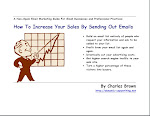A freelance copywriter’s job is to persuade. But sometimes the reader already holds the opposite point of view. How then, can the copywriter rebut that opposing opinion and then present a persuasive argument for the exact opposite?
Years before I became a freelance copywriter, I was a lawyer. And lawyers, as you know, have to write briefs and present arguments that rebut and persuade. Here’s a simple technique I used over and over again in every brief I wrote.
It involves three steps. The first step is to fully and fairly acknowledge the opposing view. In this first step, it can almost sound as though you are arguing FOR the other side. But remember, this step must fully and fairly represent the opposite opinion. If you just skim over the other side, it will show.
The key word I use for this first step is “although.” My outline will look like, “Although the plaintiff did at one time patent a design for a widget …”
The second step is where I now bring out my own argument for my own point of view. Because my reader has just seen me fully and fairly acknowledge the other side’s opinion, my own argument now has greater credibility. In fact, most readers are now inclined to lean my way because I wouldn’t (in their minds) have been so open with the opposite argument if I wasn’t absolutely sure I could support my own.
The keyword for this second step is “nevertheless.” Now the argument looks like, “Although ______, nevertheless the plaintiff’s patent does not apply to this particular widget …..”
The last step of this formula is where I bring out all my evidence that rebuts the first point of view and supports my own. Roll out every bit of proof you can find here because this evidence must tip the scales from the other side’s point of view to my own.
The keyword here is “because.” Now it all looks like, “Although _____, nevertheless ____, because the design of this widget is very different from the plaintiff’s patent, and because my client filed her patent before the plaintiff filed his design, and also because United States patent law does not protect designs filed in crayon.”
This is a very powerful persuasion technique because of the inherent fairness of the approach. People already understand that your opposition is not without some merit. Because of this, they tend to give more weight to the side that will meet an opposing argument head on, not misrepresent it and play fair.
Where might you use this technique? Generally it will be used in an analytical type of document like a white paper or a proposal. In these instances, credibility and thorough thinking is essential to persuasion.
freelance copywriter, writing web content, white papers, copywriting tips
Labels: copywriting ideas



0 comments:
Post a Comment